In this second part of the series, we continue our journey by discussing evergreen perennial plants for the container garden.
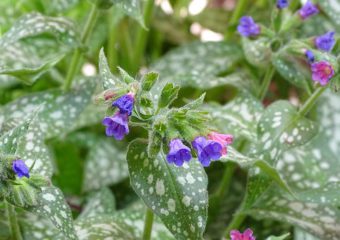
This time, we will be discussing from Lamium to Waldsteinia, and many plants between. So you are sure that in this two-part series that there is as evergreen or semi-evergreen perennial for your own personal taste. Some of them have beautiful autumn and winter colours and so should add interest to any container garden. Part 1 can be found here.
You can use evergreen plants dispersed throughout the container garden to stop pots looking vacant, unloved and underutilized.
What follows are the evergreen perennial plants that I recommend to grow in containers:
LAMIUM (Dead Nettles)
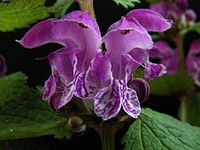
This is a foliage plant that is often grown for its leaves rather than its flowers. This perennial grows up to 30cm in height, but it is a quick spreader. The nettle-like leaves are usually striped or have splashes of silver margins. In spring or early summer white, pink, mauve or yellow flowers appear.
Grow this perennial in a well-drained, multipurpose compost in partial or full shade.
LEWISIA

This is one of the most colourful of all rockery perennial where flowers of pink, peach, orange, or white appear. The flower petals are often striped, so add more attraction. The fleshy, green leaves come in a rosette of long, narrow leaves. The flower grows on top of these rosettes on small spikes, where it can grow up to 30cm in height.
The major drawback is that this perennial does not like water at the heart of the plant, as it will cause it to rot.
To avoid this you need to adapt your planting method. Instead of planting on top of the container you need to cut a hole in the side of the container and plant it within that hole. Alternatively, you can buy containers will holes in the side, such as the strawberry barrel that has been reviewed here. This will make sure that the plant survives. It prefers to be grown in a gritty, well-drained, multipurpose compost in full sun.
LIBERTIA

Most herbaceous perennial container displays either have no plant visible in them, as they have died back to nothing or they are brown and lifeless in winter. Not so with Libertia as the large, sword-like leaves are evergreen. In midsummer, this 75cm tall plant produces flower stalks bearing white or blue sprays.
Each bloom has three triangular-shaped outer petals and three smaller, inner ones. In autumn the flowers have produced attractive brown seed heads. Grow this plant in a well-drained, enriched, multipurpose compost in full sun.
LIMONIUM (Sea Lavender)
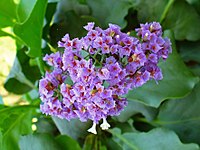
Limonium come as either an annual or perennial depending on which variety is grown. No matter if the annual or perennial is used the flowers can be used for flower arranging, where the cut flowers can be used for indoor decorations.
The perennial Limonium is grown for its evergreen, large heart-shaped leaves and for its frothy clouds of tiny, violet-blue, or lavender flowers that appear in summer. The flowers appear on top of the lush, green leaves. This 75cm tall plant can be cut, as said previously. To do this you need to cut the flower before they are fully opened and then tie the stems into bunches. They should be left to dry by hanging upside down in a cool place, such as a garage and away from direct sunlight.
Perennials can be grown under glass in spring where the seeds can be planted in a well-drained multipurpose compost in full sun.
LIRIOPE (Lily Turf)

This 45cm tall perennial resembles an oversized grape hyacinth when it is in flower. The arching grassy-like evergreen leaves split into clumps, where in late summer to early autumn, upright spikes of tiny mauve, lavender, or violet bell-shaped flowers appear.
The plant can be invasive and would require to be divided to stop them from becoming root-bound. Grow it in a multipurpose compost in full sun or partial shade, The flower when faded needs to be deadheaded.
MARINA
This unusual evergreen perennial has been described in great detail before in unusual plants for the container garden, and so will not be repeated here.
NEPETA (Catmint)

This 90cm tall perennial is popular with gardeners and cats alike. It is an attractive plant with aromatic grey-green leaves and its tolerance of many types of soils and compost. It does not like the compost to be too wet, as this will kill it.
Tall flowering spikes appear through early spring to early autumn, where purple, white, or blue flowers appear.
Deadheading encourages more flowers to be produced, whilst old grown should be removed in spring when new shoots appear.
Grow it in a well-drained, multipurpose compost in full sun.
PARAHEBE
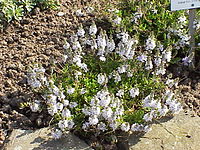
This category arose when some time ago the genus Veronica was split into shrubs (Hebes, which are woody), and the herbaceous perennial Veronica. The problem is that some of the plants did not fall into either group. This is why Parahebes species was borne.
This perennial produces 27cm tall plants that are semi-woody. They produce small white, blue, or pink, single flower, which are borne in loose clusters. The flowers appear from late summer to autumn. The small leaves themselves can be attractive, and come in many shades of green, some variegated.
Grow this attractive plant in a well-drained, multipurpose compost in full sun.
POLYGALA (Milkwort)
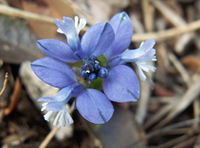
This is a low growing, up to 7.5cm tall, spreading perennial that produces a mat of leathery, green leaves. In late spring, blue or purple yellow-striped flowers appear on top of the leathers leaves en masse.
Not often seen in gardens but worth looking for. Grow this perennial in gritty, well-drained, multipurpose compost in full sun.
PRUNELLA (Self Heal)

Selfheal is a 23cm tall matt-forming, evergreen perennial that is often grown underneath shrubs. Its leaves are oval-shaped and dark, green but not very interesting. In midsummer tall flowering spikes appear where each spike bears a cluster of tubular, hooded, dark-lipped purple, mauve, or pink flowers. Can be invasive plant, so it is best to divide it every 2 to 3 years to keep it under controlled.
Grow this perennial in multipurpose compost in light shade.
PULMONARIA (Lungwort)
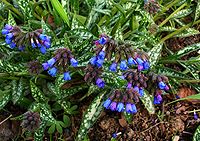
This is a firm favourite where white-spotted, oval-shaped, green leaves provide excellent ground cover. The plant grows up to 30cm in height where in spring, pink or blue flowers are produced in large quantities.
In containers, you will need to lift and divide the plant every few years. Grow this colourful specimen in well-drained, multipurpose compost in partial shade.
RUTA (Rue)

A woody-herbaceous perennial that is often grown as a rounded bush. It grows up to 90cm tall, where deeply divided blue-green, aromatic leaves are seen, ‘Variegata’ has blotched cream-green leaves, which makes a great alternative. In June-July insignificant green-yellow flowers appear. This is a plant grow for its leaves and not its flowers.
If you grow Rue make sure that you wear gloves when handling the leaves as the sap can cause a severe and long-lasting rash.
Plant this attractive plant in multipurpose compost in full sun or partial shade,
SAXIFRAGA (Saxifrage)

Most saxifrages comes from mountain regions and are low growing and spreading, There a wide range of species, all having different height from 5cm to 45cm. The species themselves all have different types of leaves and sizes, which makes then very interesting.
All of them have leafy rosettes or a mossy mat. From this upright stalks that have clusters of star-shaped flower that appear from spring to early summer. The blooms came in a vast array of colours from white, pink, red, yellow or purple. There is a lot of variation in varieties.
Grow this perennial in well-drained, multipurpose compost in light shade. They do not do well in full sun.
SEMPERVIVUM (Houseleek)
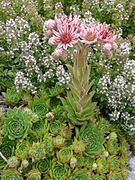
This succulent is a popular variety where thick flower stalks appear in summer or autumn. The flowers that ate borne are usually yellow, red, or purple and are multi-petalled. There are usually not grown for these flowers but the attractive evergreen, ball-like rosettes which come in different colours, textures and hirsuteness.
What is not known is that the base of the flower stalk dies when flowering comes to the end. This makes the plant look bare as it ages.
Plant this plant in well-drained, multipurpose compost in full sun.
SENECIO
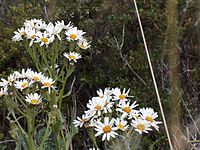
Senecio is found in the house and it is found in the garden. You will find it as a houseplant, a shrub and a bedding plant. Saying that the hardy perennial are few in number and not often seen.
The usual species seen is S. smithii, which is a plant for moist containers. It grows up to 1.2m in height where 30cm long green leaves are borne on stout stems. In June-July, small, daisy-like, white, yellow-centred flowers are produced in clusters on top of spikes.
Grow this perennial in a moisture-retentive, multipurpose compost in full sun.
SILENE (Campion)
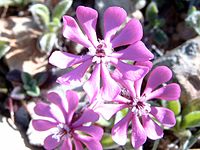
These perennial species are more popular than the annuals. Most of them have green, soft, hairy leaves that look attractive. On top of short stems, pink, white or red, flat-faced, tubular flowers are produced in summer. The flowers are blunt-ended and often notched.
The most important aspect of this mat-forming perennial is that they keep some bloom, even in winter, where nothing is really in flower.
Grow this perennial in well-drained, gritty, multipurpose compost in full sun.
SISYRINCHIUM

This is a member of the iris family, which produces erect fan of evergreen, sword-like leaves. Look out for ‘Aunt May’ that has cream-striped leaves. In summer simple, six-petal stars or bell-shaped flowers appear. The flowers are not long-lasting but appear over a long period of time. The flowers are white-yellow, white, or blue.
Grow this perennial in well-drained, enriched, multipurpose compost in full sun.
STACHYS (Lamb’s Ear)

The popular lamb’s ear grows up to 60cm in height where grey-leaves are produced. Flowers are borne in whorls on upright tall spikes, where tubular purple, or white flowers are observed. The flowers, in general, are insignificant but the attractive leaves make it a must for any container garden.
Grow this perennial in a well-drained, multipurpose compost in full sun.
SYMPHYTUM (Comfrey)
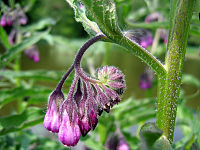
This is a vigorous perennial that prefers to be grown in shady sites. This 90cm tall perennial has large, oval, evergreen leaves. Some have mottled green leaves, which makes them look more spectacular.
In late spring, drooping heads of tubular flowers appear that are creamy yellow, pink, blue, or purple-pink in colour.
Grow this plant in multipurpose compost in full sun or partial shade. The plant can be invasive, so may need frequent division.
It can also cause a nasty rash if the leaves come into contact with the skin.
TELLIMA

This 45cm tall perennial at first glance look like a Tiarella, as it has lobed, semi-evergreen leaves that are heavily veined. The difference is noted as Tellima has wide fringed, bell-shaped flowers that are pale green in colour. This is unlike the frothy star-like flowers of tiarella. The flower of Tellima turn increasingly pink as it matures.
Look out for ‘Purpurea’ which has purple leaves and pink-edged flowers and ‘Odorata’, which has a divine scent.
This plant has some drought resistance and does best grown in well-drained, multipurpose compost in full sun or partial shade.
THYMUS (Thyme)

Thyme is a feature of most herb garden, but this is not their only use, as they can be a decorative garden plant. It should be more widely grown as a profusion of flowers appear in early summer. An easy to grow plant.
It can grow up to 30cm in height where trailing stems with small, oval or lance-shaped green leaves appear. On top of these small leaves, heads of tiny, pink, dark pink, white, mauve or red flowers appear. There are many varieties of thyme perennial available: there are the spreading carpeting varieties or there are the dwarf, bushy varieties so you have plenty to choose from.
To add interest, you could buy variegated varieties, which have silver-green leaves, golden-edged green leaves, or yellow-splashed green leaves. Grow this perennial in a sandy, well-drained multipurpose compost in full sun.
TIARELLA
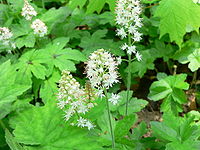
This evergreen perennial that grows up to 60cm in height provides useful winter interest. The foliage turns bronze or red in winter, which add colour to where everything is lifeless.
The leaves are lobed and predominantly veined where in early summer spikes of small, white starry-shaped flowers appear. The flowers look like white froth when observed from afar.
Grow this perennial in a moisture-retentive, multipurpose compost in partial shade.
WALDSTEINIA
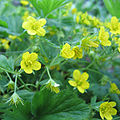
This low-growing, semi-evergreen, spreading perennial only grows up to 10cm in height. The surface-rooted stems produce a mass of lobed green leaves that turn a golden colour in autumn. In spring yellow potentilla-like flowers are produced that are held in loose clusters. It is, in fact, a member of the rose family, with five petals in each flower.
The leaves do look similar to strawberry leaves. It can be invasive and so may need to be tamed by cutting back.
Grow this perennial in well-drained, multipurpose compost in partial shade.
CONCLUSIONS
In this second and final part of the evergreen perennial plants for the container garden. As you can see there are numerous plants covering different heights, forms, colours, but all having the fact that they are evergreen or semi-evergreen.
This implies that during winter at the most dreary time of the year, will add colour and interest.
Otherwise, you will end up with plenty of empty containers, looking bland until the deciduous perennials re-emerge in the following spring, or new annual are planted.
Evergreens fill this void and should be grown in containers gardens.
If you have a question or comment you wish to raise, please do so in the comment box below.
Keep yourself evergreen.

I read through the part one of this post already and I picked quite a handful from there. However, going by the things I am seeing in this list of perennial plants here, I can only say a big thank you for sharing all these beautiful plants here. I cannot seem to place it well enough the ones I should say pick my interest well but then, I love the innocence of the polygala.
Hi RoDarrick
As ever I am grateful for your comments and wisdom, as they add something interesting to my website. I am glad you enjoyed my articles as I want to get into people’s minds that winter does not have to be lifeless and that greenery can be observed with my plant lists.
Kind regards
Antonio
Hi Antonio
Thank you very much of the article on evergreen perennials that would add life to any garden. You have a wonderful way of describing plants that you make choosing so hard to do, as all of them look do wonderful and vibrant. I thought the first part was brilliant but the second part top this with more wonderful plants. You sir, are a wonderful gardener.
Hi Bernie
Thank you for those wonderful and kind words. I try my best to help people as much as possible and know that people like you will get a lot out of it.
Kind regards
Antonio